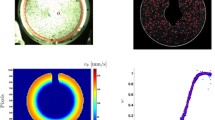Abstract
The fundamental processes related to the removal of fine particles from surfaces in a hydrodynamic flow field are not adequately understood. A critical particle Reynolds number approach is proposed to assess these mechanisms for fine particles when surface roughness is small compared to particle diameter. At and above the critical particle Reynolds number, particle removal occurs, while below the critical value, particles remain attached to a surface. The system under consideration consists of glass particles adhering to a glass surface in laminar channel flow. Our results indicate rolling is the removal mechanism, which is in agreement with the literature. Theoretical results of the critical particle Reynolds number model for rolling removal are in general agreement with experimental data when particle size distribution, particle and surface roughness, and system Hamaker constant are taken into account.
Similar content being viewed by others
References
Ali I., R. Sudipto & G. Shinn, 1994. Chemical-mechanical polishing of interlayer dielectric: A review. Solid State Technol. 37, 63.
Amick J.A., 1976. Cleanliness and the cleaning of silicon wafers. Solid State Technol. 19, 47.
Busnaina A., J. Taylor & I. Kashkoush, 1993. Measurement of the adhesion and removal forces of submicrometer particles on silicon substrates. J. Adhes. Sci. Tehcnol. 7, 441.
Cooper K., 2000. A Fundamental and Experimental Study into the Adhesion of Micron-Scale Particles to Thin Films. Ph.D. Thesis, Arizona State University.
Cooper K., N. Ohler, A. Gupta & S. Beaudoin, 2000a. Analysis of contact interactions between a rough deformable colloid and a smooth substrate. J. Colloid Interface Sci. 222, 63.
Cooper K., A. Gupta & S. Beaudoin, 2000b. Substrate morphology and particle adhesion in reacting systems. J. Colloid Interface Sci. 228, 213.
de Larios J.M., J. Zhang, E. Zhao, T. Gockel & M. Ravkin, 1997. Evaluating chemical mechanical cleaning technology for post-CMP applications. Micro. 15, 61.
Fuller K.N.G. & D. Tabor, 1975. The effect of surface roughness on the adhesion of elastic solids. Proc. R. Soc. Lond. A. 345, 327.
Heroux J.B., S. Boughaba & I. Ressejac, 1996. CO2 Laser-assisted removal of submicron particles from solid surfaces. J. Appl. Phys. 79, 2857.
Hubbe M., 1984. Theory of detachment of colloidal particles from flat surfaces exposed to flow. Colloid Surf. 12, 151.
Hymes D., H. Li, E. Zhao & J. de Larios, 1998. The challenges of the copper CMP clean. Semicond. Int. 21, 117.
Johnson K.L. & J.A. Greenwood, 1997. An adhesion map for the contact of elastic spheres. J. Colloid Interface Sci. 192, 326.
Kern W., 1990. The evolution of silicon wafer cleaning technology. J. Electrochem. Soc. 137, 1887.
Khilnani A., 1988. Cleaning semiconductor surfaces: Facts and foibles. In: Mittal K. (ed.), Particles on Surfaces I: Detection, Adhesion, and Removal. Plenum Press, p. 17.
Krishnan S., A.A. Busnaina, D.S. Rimai & L.P. DeMejo, 1994. The adhesion-induced deformation and the removal of submicrometer particles. J. Adhes. Sci. Technol. 8, 1357.
Liu C., B. Dai & C. Yeh, 1996. Post cleaning of chemical mechanical polishing process. Appl. Surf. Sci. 92, 176.
Maugis D., 1992. Adhesion of spheres: The JKR-DMT transition using a Dugdale model. J. Colloid Interface Sci. 150, 243.
Maugis D. & H.M. Pollock, 1984. Surface forces, deformation, and adherence at metal microcontacts. Acta Metall. 32, 1323.
Murkami M., 1997. Post-CMP cleaning: Removing 0.2 µm particles. Semicond. Int. 20, 56.
O'Neill M., 1968. A sphere in contact with a plane wall in a slow linear shear flow. Chem. Eng. Sci. 23, 1293.
Rimai D.S., L.P. De Mejo & R.P. Bowen, 1990. Surface-forceinduced deformations of monodisperse polystyrene spheres on planar silicon substrates. J. Appl. Phys. 68, 6234.
Rimai D.S., L.P. DeMejo, W. Vreeland, S.R. Gaboury & M.W. Urban, 1992. The effect of Young's modulus on the surface-force-induced contact radius of spherical glass particles on polyurethane substrates. J. Appl. Phys. 71, 2253.
Rimai D.S., R.S. Moore, R.C. Bowen, V.K. Smith & P.E. Woodgate, 1993. Determination of the dependence of the surface force induced contact radius on particle radius: Cross-linked polystyrene spheres on SiO2/Silicon. J. Mater. Res. 8, 662.
Roy S.R., I. Ali, G. Shinn, N. Furusawa, R. Shah, S. Peterman, K. Witt & S. Eastman, 1995. Postchemical-mechanical planarization cleanup process for interlayer dielectric films. J. Electrochem. Soc. 142, 216.
Soltani M. & G. Ahmadi, 1994. On particle adhesion and removal mechanisms in turbulent flows. J. Adhes. Sci. Technol. 8, 763.
Tabor D., 1977. Surface forces and surface interactions. J. Colloid Interface Sci. 58, 2.
Visser J., 1972. On Hamaker constants: A comparison between Hamaker constants and Lifshitz-van derWaals constants. Adv. Colloid and Interface Sci. 3, 331.
Visser J., 1976. Adhesion of colloidal particles. In: Matijevic E. (ed), Surface and Colloid Science. John Wiley & Sons, Inc., p. 3.
Visser J., 1995. Particle adhesion and removal – A review. Part. Sci. Technol. 13, 169.
Weiss N.A., 1999. Elementary Statistics, 4th ed., AddisonWesley Longman, Inc.
White F.M., 1974. Viscous Fluid Flow, McGraw-Hill, Inc.
Yiantsios S.G. & A.J. Karabelas, 1995. Detachment of spherical microparticles adhering on flat surfaces by hydrodynamic forces. J. Colloid Interface Sci. 176, 74.
Author information
Authors and Affiliations
Corresponding author
Rights and permissions
About this article
Cite this article
Burdick, G., Berman, N. & Beaudoin, S. Describing Hydrodynamic Particle Removal from Surfaces Using the Particle Reynolds Number. Journal of Nanoparticle Research 3, 453–465 (2001). https://doi.org/10.1023/A:1012593318108
Issue Date:
DOI: https://doi.org/10.1023/A:1012593318108




